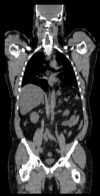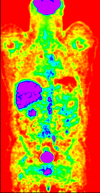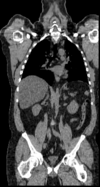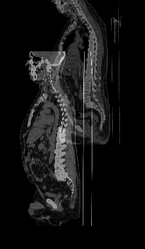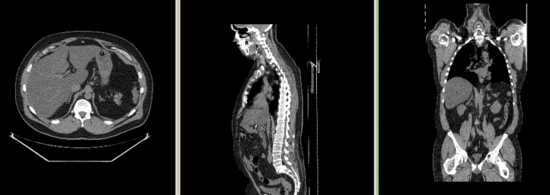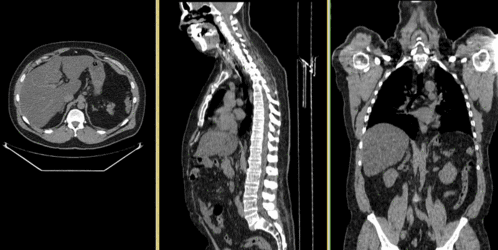Difference between revisions of "Projects:RegistrationLibrary:RegLib C08"
From NAMIC Wiki
| Line 44: | Line 44: | ||
Image:RegLib_C08_PET-CT_AnimGif.gif|Automated Affine alignment (RegisterImages) removes global differences. Differences due to posture and breathing remain. | Image:RegLib_C08_PET-CT_AnimGif.gif|Automated Affine alignment (RegisterImages) removes global differences. Differences due to posture and breathing remain. | ||
Image:RegLib_C08_PET-CT_AnimGif_BSpl1_Result.gif|BSpline registration of full volumes achieves better alignment in the abdominal and thoracic region of interest. But the solution is suboptimal because the algorithm is distracted by the strong differences in head position.Rather than trying to address this with more DOF, we calculate a BSpline transform based on croped images including only the main region of interest. | Image:RegLib_C08_PET-CT_AnimGif_BSpl1_Result.gif|BSpline registration of full volumes achieves better alignment in the abdominal and thoracic region of interest. But the solution is suboptimal because the algorithm is distracted by the strong differences in head position.Rather than trying to address this with more DOF, we calculate a BSpline transform based on croped images including only the main region of interest. | ||
| − | Image:RegLib_C08_PET-CT_AnimGif_BSpl2_ResCrop.gif|After BSpline registration of cropped volumes | + | Image:RegLib_C08_PET-CT_AnimGif_BSpl2_ResCrop.gif|After BSpline registration of cropped volumes. The registering of thoracic and abdominal regions only produces good results. We still apply this transform to the uncropped image. |
</gallery> | </gallery> | ||
Revision as of 17:48, 19 March 2010
Home < Projects:RegistrationLibrary:RegLib C08Back to ARRA main page
Back to Registration main page
Back to Registration Use-case Inventory
Contents
Slicer Registration Use Case Exampe #8: Intra-subject whole-body PET-CT
Objective / Background
Change assessment.
Keywords
PET-CT, whole-body, change assessment
Input Data
 reference/fixed : baseline CT: 0.97 x 0.97 x 3.27 mm , PET: 4.7 x 4.7 x 3.3 mm
reference/fixed : baseline CT: 0.97 x 0.97 x 3.27 mm , PET: 4.7 x 4.7 x 3.3 mm moving: CT: 0.98 x 0.98 x 5
moving: CT: 0.98 x 0.98 x 5 moving: PET: 4.1 x 4.1 x 5 mm
moving: PET: 4.1 x 4.1 x 5 mm
Registration Results
BSpline registration of full volumes achieves better alignment in the abdominal and thoracic region of interest. But the solution is suboptimal because the algorithm is distracted by the strong differences in head position.Rather than trying to address this with more DOF, we calculate a BSpline transform based on croped images including only the main region of interest.
Download
Link to User Guide: How to Load/Save Registration Parameter Presets
Discussion: Registration Challenges
- accuracy is the critical criterion here. We need the registration error (residual misalignment) to be smaller than the change we want to measure/detect. Agreement on what constitutes good alignment can therefore vary greatly.
- the two series have different voxel sizes
- because of the large FOV we have strong non-rigid deformations from differences in patient/limb positions etc.
- images are large volumes (>100 MB total)
- image content reaches border of image on two sides
Discussion: Key Strategies
- the two images have identical contrast, hence we can consider "sharper" cost functions, such as NormCorr or MeanSqrd
- the contrast differences between the PET and CT far exceed the longitudinal differences in either modality. Hence, if necessary we can take advantage by registering each series separately and then build a concatenated transform.
- the two images are far apart initially, we will need some form of initialization. Manual alignment is a fast and effective approach for this.
- because accuracy is more important than speed here, we increase the sampling rate from the default 2% to 15%. Note however the large image size, which makes comparable sampling % still large compared to other datasets.
